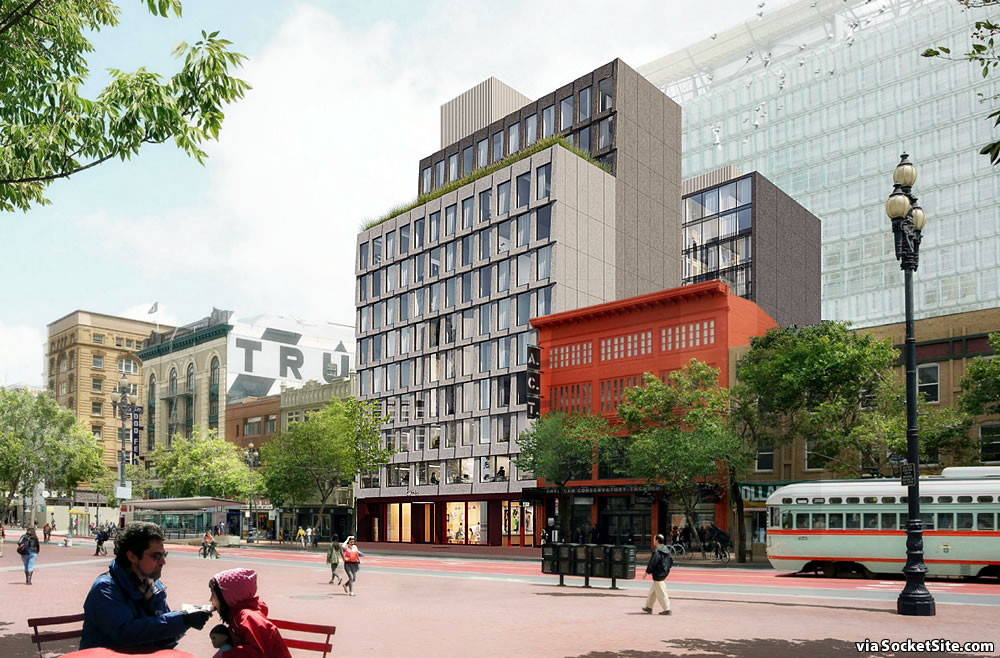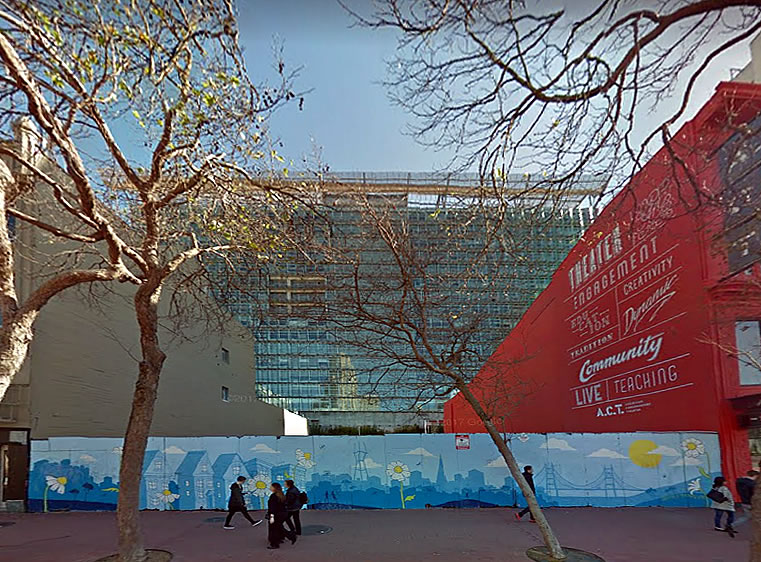The refined plans for a 12-story hotel and office building to finally rise upon the long-vacant lot at 1125 Market Street, upon which the former Bell/American/Embassy Theater once stood adjacent to the newly renovated Strand, are one big step closer to reality, with the project having effectively been cleared from an environmental perspective.
That being said, as redesigned by Woods Bagot and Leong Leong for the Pacific Eagle team, the proposed development would yield a 180-room hotel over 5,500 square feet of ground floor restaurant/retail space and 10,500 square feet of co-working office space, the demand and economics for which are likely under review.
And next week, San Francisco’s Planning Commission is slated to approve the entitlements for the proposed redevelopment of the 1125 Market Street site.
From a recently updated “Study of Potential Demand” for the development, which is slated to be flagged an Eaton Workshop and Hotel, which was commissioned by the development team and prepared by The Hudson Group:
“The current situation, as of July 30, 2020, is highly fluid, and hotel demand in San Francisco, and worldwide tourism in general, is being impacted by the COVID-19 pandemic including differing public health policies and perceptions, geopolitical issues, and economic forces, among others, on a macro basis. There is currently a lack of information relating to tourism recovery, which makes demand assessment nearly impossible.
The Eaton San Francisco is not expected to open until 2023…or later depending on approvals, material sourcing, and construction costs. At best, the hotel would open approximately two and one-half years from today. The question at hand appears to when and if it would be appropriate to re-address the demand assessment?
There are numerous articles, models, and projections relating to when demand for hotel accommodations in the US will return to 2019 levels. Recently, nearly all the models and articles indicate a recovery in 2022-2023 and, in the most stressed cases, 2024. Should market demand recover between 2022 and 2024, as is widely expected, then our forecast of demand assessment for the Eaton would be valid, as the 3/20 report indicated stabilization in 2026.
However, what is more likely is that the development of other planned lifestyle hotels in San Francisco will be abandoned or severely delayed as a result of the COVID-19 pandemic, lack of construction financing, economic turmoil, and market demand uncertainty.”
As we said, “under review.” We’ll keep you posted and plugged-in.


Hotel? A ground floor restaurant? Not likely that this project is financially viable for the medium term and perhaps the long term. The study says it all: “However, what is more likely is that the development of other planned lifestyle hotels in San Francisco will be abandoned or severely delayed as a result of the COVID-19 pandemic, lack of construction financing, economic turmoil, and market demand uncertainty.”
Expect the long vacant lot to remain so for a long time to come.
But if the development of other planned lifestyle hotels in San Francisco are “abandoned or severely delayed as a result of the COVID-19 pandemic, lack of construction financing, economic turmoil, and market demand uncertainty,” and the Eaton is built, then the demand for the Eaton could actually be greater than originally projected in its stabilized year of operation (which was originally forecast for 2026) as the number of competing properties circa 2026 would be reduced.
A game of chicken? Maybe other “competing properties” will try the same finesse? This is a highly risky project which will need more than the hope that similar hotel projects won’t go forward to get bankers to finance it. This part of Market Street is worse than ever in terms of filthy streets, crime and the homeless. Who would want to walk out of the hotel front door into the chaotic street scene just outside? BTW, the iconic Hilton Times Square just announced it will be permanently closing.
Let’s all agree on the obvious: if we’re still discussing dampened demand in 2026 – 2026!! – the issue will have long ceased to be conjectural: SF will be deep in the panic pit.
Agreed
The city will use it to house homeless and the homeless will use it as a meth lab.
SF has several pockets of over-built / over-supply, IMO….
With or without COVID, market is going to pause and take (a long) time to absorb these over supplies…
Pay back time for the 10 years of money printing….
Need way more over-built / over-supply to really reduce office/residential/commercial rent!
Builders would only build if there is a profit…. If the rent is not high enough to cover all his cost plus leave him some profit, he will not build….. As is the case here, plain and simple….
So if you want rent to drop, don’t look to the builders…. Look to Fed to stop printing money, look to CPC/DPW/DBI to streamline their processes…
Printing money has nothing to do with region specific rent prices and housing supply.
Your are technically correct. In addition to historically-extended, historically-low interest rates, the principle cause of the housing bubble was quantitative easing, which the Federal Reserve implements on computer spreadsheets by swapping deadweight Wall St securities at face value onto its asset ledger, with the banks getting the ginormous windfall from the debit column.
Vulture capitalists and PE pirates with access to these cheap trillions of dollars funded endless unicorns and stock buybacks, which filtered down to the kids who bid up Bay Area housing (along with AirBnB dabblers, RE gamblers, and foreign capital flight).
No printing press necessary!
There is absolutely not an oversupply over hotel space under even quasi-normal circumstances. That’s a big part of the reason why hotel rooms in this area have had such absurdly high nightly rates.
I think what the study doesn’t mention but will be relevant is that in the time period for a projected recovery (i.e., in 2022-2023) there will also likely be a market-flooding rush of supply from “new” AirBnB and VRBO units placed on the illegal hotel market by landlords who can’t rent their units on the regular term rental market. These rental unit vacancies will be due to the exodus of highly-paid, yet not-quite-highly-paid-enough-to-purchase-in-S.F. employees of tech firms and others like them fleeing The City to the suburbs and places outside of the Bay Area where housing for a family is affordable for purchase on their salaries coupled with the resistance of said landlords to lowering asking rents to the new, normal market-clearing price (that is, prices somewhat in line with gross incomes to local workers). And of course almost all of the pre-novel coronavirus illegal hotel rooms will be available as well, presumably at lower rental rates.
Granted, newly-placed AirBnB and VRBO units aren’t entirely interchangeable with lifestyle hotel rooms, but they will certainly decrease the level of occupancy of hotel rooms. I’d bet the lenders providing the construction financing will have a better handle on that impact than The Hudson Group.
I’d suggest that no one really knows what the Covid situation will look like one year from now, much less 2023.
And I’d suggest (i.e. we know) that this is totally at odds with all available medical evidence that we have.
At odds with what?
We can bet that the COVID situation three months from now will be drastically worse. A recent study found almost 10% of the people at 24th Street BART were HEAVILY infected. 10%.
There is no such thing as “HEAVILY infected.”
The BART news is nothing surprising. We know that SARS-CoV-2 spreads extremely rapidly and asymptomatically. The people who are taking BART are more likely to have jobs involving contact with the public, or else they’d be working from home. More contact with more people means more risk of infection.
What will make things worse is if we keep accelerating our return to normalcy before we have widespread rapid testing and tracing.
Your comment made me chuckle, even if it wasn’t meant to be funny, and I concur with the message of your online handle.
I stayed in Eaton Hong Kong in the Jordan district prior to its odd stylized artistic bent. Never could figure out what their purpose or focus was.
It is hard to imagine how successful they can be with the same concept here but perhaps they are looking to do something with the Strand next door.
Regardless, if they want to spend the money to build it and come up with a successful hotelier business model, let them. They do have a few years to think about their concept, vision, and design.
Hotel rates as recently as Jan/Feb this year were $300-500/night. This pencils out every day of the week and twice on Sunday when this is all said and done.
Except it’s in the middle of a drug induced zombie parade. Who would want to stay there
How were the vacancy rates at Yotel, Good Hotel, and the Prosper before the pandemic hit?